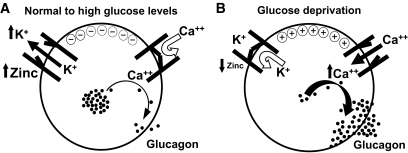FIG. 8.
Regulation of glucagon secretion by zinc. A: α-Cell electrical and hormonal status in states of physiologic and elevated glucose conditions. β-Cells release zinc and insulin hexamers into the intraislet periportal circulation. Zinc dissociates from insulin and reaches downstream α-cells, where it binds to and opens the KATP channels. K+ ions leave the cell and hyperpolarize the α-cell, thus preventing voltage-dependent calcium channels from opening. Glucagon granules are not mobilized and remain stored inside the cell. B: When blood glucose levels decrease in response to hypoglycemic levels, β-cell insulin and zinc secretion decrease as well. KATP channels on α-cells close, K+ remains in the cell, and the α-cell depolarizes, which induces calcium channels to open and calcium enters the cell. Intracellular calcium rises, inducing glucagon exocytotic granules to migrate to the plasma membrane, where they fuse and release glucagon into the portal venous system.

